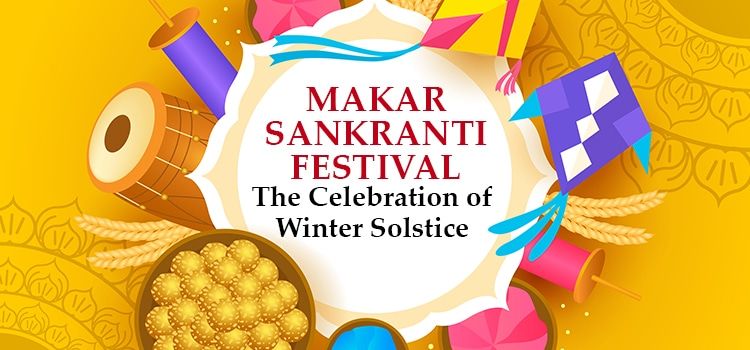Makar Sankranti is one of the important festivals celebrated in India. It is among the unique festivals in India as it happens to fall on the same day every year on January 14. The meaning of Makar Sankranti is the sun’s transition into Makara or Capricorn. Across India, it is also the harvest festival. But, there are different traditions and customs in each region. Irrespective of the names, the significance remains the same. The end of the Vedic Winter Solstice and the beginning of longer days happens during this period due to the sun journey northward. The harvest festival is a seasonal observance with religious and astrological significance.
Significance of Makar Sankranti
Religious Significance
The harvest festival or the end of Vedic Winter Solstice has religious significance attached to it. This is when the sun starts its journey northward called ‘Uttarayan’. As per Mahabharatha, this is the day Bhishma Pitamaha left his soul. For those who are not aware of this epic, young Bhishma got a boon from Devavrata to choose the day and time of his death. Bhishma opted for this day when the sun made the journey to the Northern Hemisphere.
Another significance here is that for the Gods, the six months of the Uttarayana is a single day, and the other six months, called the Dakshinayan, are a single night. So as per Hindu tradition, a year is a single day for the Gods.
On this day, the belief is that people should take a dip in the holy rivers of Ganga to wash their sins. So people go to fairs like Gangasagar Mela at Sagardwip, West Bengal and take a dip at the banks of Ganges on Makar Sankranti. Kumbh Mela in Prayag, which happens every 12 years, falls on this auspicious day.
Astrological Significance
On this Vedic winter solstice, there is a great deal of zodiac movement of the earth around the sun. This movement produces a significant effect on the planet from this day and brings new changes. That is because of the strong Northward movement of the sun. From the day of Makara Sankranti, the winter starts to recede, and the days become longer and the nights shorter. For the Yogis, this is an auspicious and important time. They make a fresh and new effort in their spiritual progress. The same goes even for the common people; they start life afresh and attempt to succeed in life.
Makara Sankranti Celebrations in India
The Makara Sankranti, known by various names in various states, is a pan India festival.
· In Goa and Maharashtra, the festival takes place for three days, called the Bhogi, Sankrant, and Kinkrant. To honour the Goddess Sankranti who killed the demon Sankrasur Raksasa Sankranti is observed.
· In Telangana and Andhra Pradesh, this festival happens for four days. On the first day, bonfires are lit, and people gather and celebrate. On the second day, livestock gets special food to honour their hard work. On the third day, they pay tributes to nature and give gifts to Gods and Goddesses.
· In Odisha, they believe that Lord Surya got over his anger with his son Shani and paid a visit. Offering fresh fruits to Lord Surya is a part of the celebration.
· In Karnataka, Sankranti is Suggi, where they offer their first harvest to God. Women and girls exchange jaggery, dried coconut, sesame seeds, and groundnuts.
· Haryana and Delhi uniquely celebrate this festival. Men go bearing gifts to their sisters’ homes. Women give gifts to their in-laws and also sing folk songs.
Common Rituals performed during Sankranti
Across the states, the harvest festival is done for 3 to 4 days, with each day having some rituals. Some of them are common across all states, and those are:
· Kite flying: Across the country, this is a common ritual where the sky has colourful kites and sky lanterns. Villagers conduct Kite flying competitions with great vigour.
· Harvesting new crops like sugarcane and paddy with the first crop offered to the village deities.
· A dip in the holy waters of Ganga, Godavari, Yamuna, Kaveri, and Krishna to wash away the sins.
· Worshipping of the Sun God who is a symbol of wisdom and divinity.
· Folk songs, bonfires, and Bhogi, Lohri, and Meji.
· Exchange of food made from til, jaggery, and dry coconut to keep the body warm as winter dries the skin.
Celebrations in Nepal
Another country that celebrates this festival apart from India is Nepal. The last day of Poush month, when all religious festivals are forbidden, is celebrated as Sankranti in Nepal. People take a dip in the holy waters to wash their sins. It is a tradition where the mother wishes good health to the family. The ritual is to exchange food made from ghee, yam, sweet potatoes, and sesame laddoos among families.
Makara Sankranti, the only festival celebrated as per the solar cycle, is unique as it falls on the same day. It is a festival that everyone looks forwards to for the sweets, kite flying and of course the warmer days!









Comments & Discussion
7 COMMENTS
Please login to read members' comments and participate in the discussion.